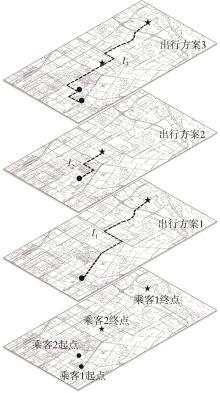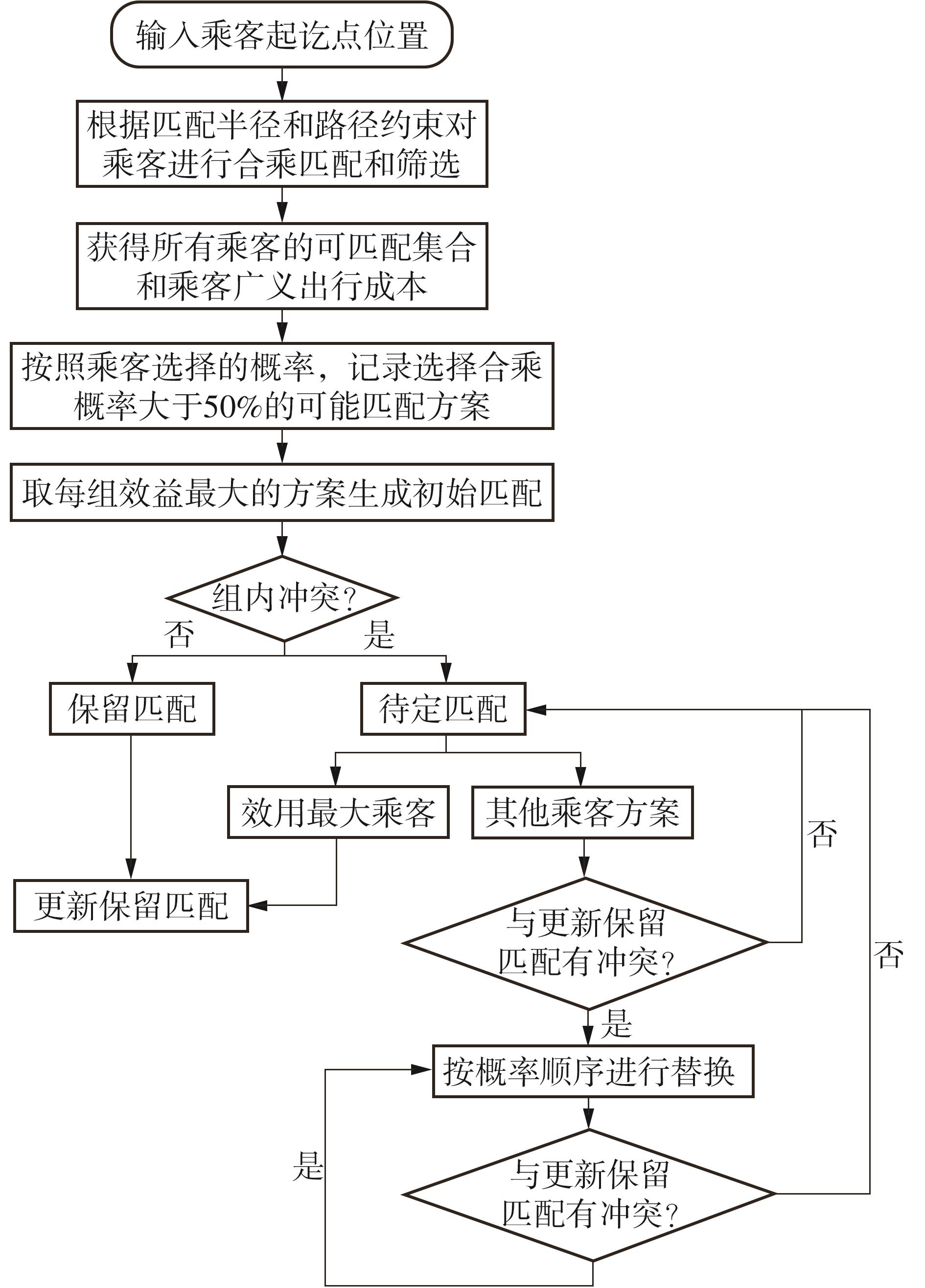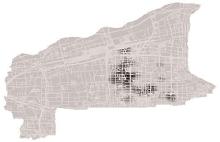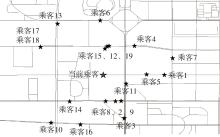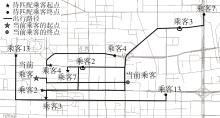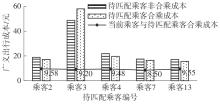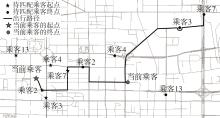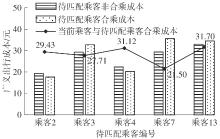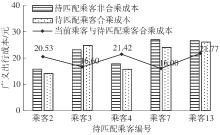Journal of South China University of Technology(Natural Science Edition) ›› 2025, Vol. 53 ›› Issue (6): 119-130.doi: 10.12141/j.issn.1000-565X.240365
• Intelligent Transportation System • Previous Articles Next Articles
Carpooling Matching Method for Ride-Hailing Considering Passengers’ Time-Price Elasticity
LONG Xueqin( ), ZHAI Manrong, WANG Yuanze, MAO Jianxu
), ZHAI Manrong, WANG Yuanze, MAO Jianxu
- College of Transportation Engineering,Chang’an University,Xi’an 710064,Shaanxi,China
-
Received:2024-07-15Online:2025-06-10Published:2024-12-06 -
Supported by:the Natural Science Basic Research Program of Shaanxi Province(2024JC-YBMS-338)
CLC Number:
Cite this article
LONG Xueqin, ZHAI Manrong, WANG Yuanze, MAO Jianxu. Carpooling Matching Method for Ride-Hailing Considering Passengers’ Time-Price Elasticity[J]. Journal of South China University of Technology(Natural Science Edition), 2025, 53(6): 119-130.
share this article
Table1
SP questionnaire design"
| 情景 | 选项 | 行驶时间/min | 行驶距离/km | 费用/元 |
|---|---|---|---|---|
| 情景选择1 | 非合乘 | 18 | 6.5 | 15.0 |
| 合乘 | 21 | 8.0 | 12.0 | |
| 情景选择2 | 非合乘 | 12 | 3.5 | 11.0 |
| 合乘 | 17 | 5.0 | 9.0 | |
| 情景选择3 | 非合乘 | 30 | 10.5 | 25.0 |
| 合乘 | 41 | 15.0 | 15.0 | |
| 情景选择4 | 非合乘 | 18 | 6.5 | 15.0 |
| 合乘 | 21 | 8.0 | 9.0 | |
| 情景选择5 | 非合乘 | 30 | 10.5 | 25.0 |
| 合乘 | 32 | 10.5 | 23.0 | |
| 情景选择6 | 非合乘 | 12 | 3.5 | 11.0 |
| 合乘 | 14 | 3.5 | 9.0 | |
| 情景选择7 | 非合乘 | 30 | 10.5 | 25.0 |
| 合乘 | 41 | 15.0 | 20.0 | |
| 情景选择8 | 非合乘 | 12 | 3.5 | 11.0 |
| 合乘 | 15 | 4.5 | 8.0 | |
| 情景选择9 | 非合乘 | 18 | 6.5 | 15.0 |
| 合乘 | 23 | 8.5 | 10.5 | |
| 情景选择10 | 非合乘 | 30 | 10.5 | 25.0 |
| 合乘 | 35 | 13.0 | 20.0 |
Table 2
Impact variables and levels"
| 类别 | 变量名称 | 符号 | 变量水平 |
|---|---|---|---|
| 个人属性变量 | 性别 | w1 | 2种水平:男,女 |
| 年龄 | w2 | 4种水平:18岁以下,18~25岁,26~35岁,35岁以上 | |
| 职业 | w3 | 8种水平:学生,个体工商户,在职人员,家庭主妇,待业,离退休人员,打零工/散工,其他从业人员 | |
| 收入 | w4(学生) | 5种水平:1 000元以下,1 000~1 500元,1 500~2 000元,2 000~3 000元,3 000元以上 | |
| w5(其他职业) | 5种水平:3 000元以下,3 000~5 000元,5 000~7 000元,7 000~10 000元,10 000元以上 | ||
| 选择方案特性变量 | 出行时间 | t1(合乘) | 3种水平:12 min,18 min,30 min |
| t2(非合乘) | 8种水平:14 min,15 min,17 min,21 min,23 min,32 min,35 min,41 min | ||
| 出行距离 | d1(合乘) | 3种水平:3.5 km,6.5 km,10.5 km | |
| d2(非合乘) | 8种水平:3.5 km,4.5 km,5.0 km,8.0 km,8.5 km,10.5 km,13.0 km,15.0 km | ||
| 出行费用 | c1(合乘) | 3种水平:11.0 元,15.0 元,25.0 元 | |
| c2(非合乘) | 7种水平:8.0 元,9.0 元,10.5 元,12.0 元,15.0 元,20.0 元,23.0 元 |
Table 7
Time-price elasticity for possible matching passengers"
| 乘客 | 合乘 | 非合乘 | 乘客 | 合乘 | 非合乘 | ||
|---|---|---|---|---|---|---|---|
| 乘客1 | 2.22 | 2.83 | 乘客11 | 2.22 | 2.83 | ||
| 乘客2 | 0.94 | 1.15 | 乘客12 | 0.94 | 1.15 | ||
| 乘客3 | 2.22 | 2.83 | 乘客13 | 0.12 | 0.19 | ||
| 乘客4 | 0.94 | 1.15 | 乘客14 | 0.12 | 0.19 | ||
| 乘客5 | 0.94 | 1.15 | 乘客15 | 0.12 | 0.19 | ||
| 乘客6 | 2.22 | 2.83 | 乘客16 | 0.94 | 1.15 | ||
| 乘客7 | 0.12 | 0.19 | 乘客17 | 0.12 | 0.19 | ||
| 乘客8 | 0.94 | 1.15 | 乘客18 | 0.94 | 1.15 | ||
| 乘客9 | 0.12 | 0.19 | 乘客19 | 0.94 | 1.15 | ||
| 乘客10 | 2.22 | 2.83 | 当前乘客 | 0.12 | 0.19 | ||
Table 10
Calculation results of models with different elasticity values for current passenger"
| 方案 | ||||||
|---|---|---|---|---|---|---|
| P1/% | ||||||
| 1 | -6.08 | 0.0 | -4.42 | 11.74 | 3.66 | -16.89 |
| 2 | 0.15 | 0.0 | -9.12 | 14.58 | 2.73 | -13.03 |
| 3 | -7.66 | 0.0 | -5.53 | 11.63 | 3.05 | -21.10 |
| 4 | 0.70 | 93.6 | 2.69 | 15.96 | 9.33 | -2.36 |
| 5 | -8.21 | 0.0 | -6.73 | 14.75 | 4.01 | -22.40 |
| 6 | -4.73 | 68.6 | 0.78 | 20.24 | 10.51 | -14.79 |
| 7 | -3.66 | 0.0 | -8.71 | 19.97 | 5.62 | -13.30 |
| 8 | 0.33 | 75.3 | 1.11 | 18.89 | 10.02 | -15.70 |
| 1 | LI W, PU Z, LI Y,et al .Characterization of ridesplitting based on observed data:a case study of Chengdu,China[J].Transportation Research Part C:Emerging Technologies,2019,100:330-353. |
| 2 | LIN J, HUANG S, JIAU M .An evolutionary multiobjective carpool algorithm using set-based operator based on simulated binary crossover[J].IEEE Transactions on Cybernetics,2019,49(9):3432-3442. |
| 3 | ZHANG X, ZHANG X .A set-based differential evolution algorithm for QoS-oriented and cost-effective ridesharing[J].Applied Soft Computing,2020,96:106618/1-11. |
| 4 | BROWN A E .Who and where rideshares?Rideshare travel and use in Los Angeles[J].Transportation Research Part A:Policy and Practice,2020,136:120-134. |
| 5 | de SOUZA SILVA L A, de ANDRADE M O, ALVES MAIA M L .How does the ride-hailing systems demand affect individual transport regulation?[J].Research in Transportation Economics,2018,69(SI):600-606. |
| 6 | 缪格,袁鹏程 .基于优化遗传算法的网约车合乘模型[J].计算机系统应用,2022,31(12):287-293. |
| Ge MIU, YUAN Peng-cheng .Ride-sharing model of online car-hailing based on optimized genetic algorithm[J].Computer Systems & Applications,2022,31(12):287-293. | |
| 7 | 曹弋,周泽禹,李金洋 .考虑驾乘人员公平性的网约出租车合乘路径优化模型[J].控制理论与应用,2022,39(7):1281-1288. |
| CAO Yi, ZHOU Ze-yu, LI Jin-yang .Optimization model of ride-sharing path for taxis online considering passenger fairness[J].Control Theory & Applications,2022,39(7):1281-1288. | |
| 8 | JIAO G P, RAMEZANI M .Incentivizing shared rides in e-hailing markets:dynamic discounting[J].Transportation Research Part C:Emerging Technologies,2022,144:103879/1-19. |
| 9 | FENG H, RUICHUN H, SENGBIN Y,et al .Research on optimization model of taxi-carpooling expenses based on the passengers’ personalized demand[C]∥ Proceedings of the 3rd International Conference on Transportation Information and Safety (ICTIS2015).WuHan:IEEE,2015:246-249. |
| 10 | 李兴华,冯飞宇,成诚,等 .网约拼车服务选择偏好分析及建模[J].吉林大学学报(工学版),2022,52(3):578-584. |
| LI Xing-hua, FENG Fei-yu, CHENG Cheng,et al .Choice preference analysis and modeling of ridesplitting service[J].Journal of Jilin University (Engineering and Technology Edition),2022,52(3):578-584. | |
| 11 | ZHANG H, ZHAO J .Mobility sharing as a preference matching problem[J].IEEE Transactions on Intelligent Transportation Systems,2019,20(7):2584-2592. |
| 12 | 薛守强,宋瑞,安久煜,等 .感知乘客心理的出租车动态合乘优化方法[J].交通运输系统工程与信息,2021,21(2):205-210,250. |
| XUE Shouqiang, SONG Rui, AN Jiuyu,et al .Dynamic shared taxi optimization method considering passengers perceptions[J].Journal of Transportation Systems Engineering and Information Technology, 2021,21(2):205-210,250. | |
| 13 | 王志建,郭健,张强.考虑乘客信任程度的营运车辆合乘线路规划[J].计算机应用研究,2023,40(4):996-999. |
| WANG Zhijian, GUO Jian, ZHANG Qiang .Planning of ride-sharing routes for operating vehicles considering degree of passenger trust[J].Application Research of Computers,2023,40(4):996-999. | |
| 14 | 彭子烜,魏然,单文轩,等 .基于稳定匹配的网约车合乘优化[J].重庆交通大学学报(自然科学版),2023,42(12):106-112. |
| PENG Zixuan, WEI Ran, SHAN Wenxuan,et al .Ride sharing optimization based on stable matching [J].Journal of Chongqing Jiaotong University (Natural Science),2023,42(12):106-112. | |
| 15 | 贾洪飞,邵子函,杨丽丽 .终点不确定条件下网约车合乘匹配模型及算法[J].吉林大学学报(工学版),2022,52(3):564-571. |
| JIA Hong-fei, SHAO Zi-han, YANG Li-li .Ride⁃sharing matching model and algorithm of online car-hailing under condition of uncertain destination[J].Journal of Jilin University (Engineering and Technology Edition),2022,52(3):564-571. | |
| 16 | MOHAMED M J,RYE T, FONZONE A .Operational and policy implications of ridesourcing services:a case of uber in London,UK[J].Case Studies on Transport Policy,2019,7(4):823-836. |
| 17 | 彭子烜,崔林,郭志伟,等 .网约车合乘均衡匹配与激励策略[J].华南理工大学学报(自然科学版),2024,52(2):95-103. |
| PENG Zixuan, CUI Lin, GUO Zhiwei,et al .Taxi-sharing matching equilibrium under peer-passenger incentive mechanism [J].Journal of South China University of Technology (Natural Science Edition),2024,52(2):95-103. | |
| 18 | 袁振洲,陈思媛,吴玥琳,等 .考虑行驶时间不确定性的合乘路径鲁棒优化方法[J].交通运输系统工程与信息,2022,22(5):233-242. |
| YUAN Zhen-zhou, CHEN Si-yuan, WU Yue-lin,et al .Robust optimization of carpooling routing problem under travel time uncertainty[J].Journal of Transportation Systems Engineering and Information Technology,2022,22(5):233-242. | |
| 19 | 宗刚,曾庆华,魏素豪 .基于时间价值的交通出行方式选择行为研究[J].管理工程学报,2020,34(3):142-150. |
| ZONG Gang, ZENG Qinghua, WEI Suhao .Research on traffic mode choice behavior based on commuting ravel time value[J].Journal of Industrial Engineering/ Engineering Management,2020,34(3):142-150. | |
| 20 | 汪景,邵雨晨,胡华,等 .快慢车模式下早高峰时空乘车路径选择研究[J].交通运输系统工程与信息,2024,24(2):225-233. |
| WANG Jing, SHAO Yuchen, HU Hua,et al .Spatio-temporal ride path selection in morning peak for express-local trains[J].Journal of Transportation Systems Engineering and Information Technology,2024,24(2):225-233. | |
| 21 | 赵明钰,吕军威 .基于灰色关联度理论的合乘出行意愿影响因素分析[J].物流工程与管理,2023,45(3):111-114,135. |
| ZHAO Ming-yu, LV Jun-wei .Analysis of influencing factors of carpooling willingness based on grey relational theory[J].Logistics Engineering and Management,2023,45(3):111-114,135. | |
| 22 | 张薇,何瑞春,肖强,等 .考虑乘客心理的出租车合乘决策方法研究[J].交通运输系统工程与信息,2015,15(2):17-23. |
| ZHANG Wei, HE Rui-chun, XIAO Qiang,et al .A method of taxi pooling mode decision-making with passenger psycholog[J].Journal of Transportation Systems Engineering and Information Technology,2015,15(2):17-23. | |
| 23 | 倪亚洲,薛运强,刘彤,等 .基于非集计模型的公交票价弹性研究[J].交通标准化,2013(11):66-67. |
| NI Ya-zhou, XUE Yun-qiang, LIU Tong,et al .Study of bus fare elasticities based on disaggregate model[J].Traffic Engineering,2013(11):66-67. |
| [1] | XIE Kun, XING Xinyuan, DONG Honghui, et al. Workplace and Residence Identification and Travel Activity Classification Driven by Trajectory Data [J]. Journal of South China University of Technology(Natural Science Edition), 2025, 53(6): 131-139. |
| [2] | WENG Jiancheng, WU Mingzhu, WEI Ruicong, et al. Speed Prediction for Road Around Large Scale Activities Venues Considering Multiple Factors Synergism [J]. Journal of South China University of Technology(Natural Science Edition), 2024, 52(8): 34-44. |
| [3] | TANG Jinjun, REN Maoxin, LI Zhitao, et al. Optimization of Metro Feeder Bus Routes Based on Surrogate-Assisted NSGA-Ⅱ Algorithm [J]. Journal of South China University of Technology(Natural Science Edition), 2024, 52(11): 95-105. |
| [4] | Zhou Jia- zhong Zhang Dian- ye. Behavior Model of Urban Trip Chains in Multi- Mode Transportation Network [J]. Journal of South China University of Technology (Natural Science Edition), 2014, 42(2): 125-131. |
| Viewed | ||||||
|
Full text |
|
|||||
|
Abstract |
|
|||||
